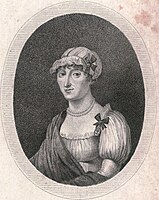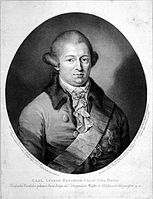Guzów, Żyrardów County
Guzów | ||
|---|---|---|
Village | ||
Country | ||
| Voivodeship | Masovian | |
| County | Żyrardów | |
| Gmina | Wiskitki | |
Guzów
History


In the late Middle Ages the lands of Guzów were a ducal estate owned by
Sugar and cloth give birth to a 'New Town'
After

In 1827 the widowed Lubieński (his wife had died in 1810), now retired from public office, put his energies into the estate. Among other developments, he established 15 new villages. However, his arguably most productive, if doomed, move was to pass the estate onto one of his seven sons, Henryk, an entrepreneur and industrialist, who had greatly contributed to the economic development of
In 1829 Henryk had also established in the vicinity of the manor one of the first sugar factories in the country, with the help of imported machinery from France.[8] However, in 1842 Henryk, by then also a bank director, was accused and convicted of 'misapplying' public funds for his private benefit. He was sent into exile and the estate was confiscated to recover his debts. There is a view that the charges were politically motivated and not based in fact. He returned from detention a broken man and took no further part in public life.
Still in the family

In 1856 the whole Guzów estate was put up for auction. In the event, it was acquired for the enormous sum of 600,000 silver roubles by
The gradually reduced Guzów estate remained in the possession of the
The palace and the landscape garden complex

Andrzej Ogiński's 18th-century substantial brick
After its use as a
The first building to be refurbished was the old palace chapel, dedicated to St. Felix of Valois and used as a parish church. With help from public heritage funds and hiring out the venue as a film set, work on the restoration is finally under way guided by a firm of specialist architects.
Trivia
In its pre-1880 French-style reconstruction, the Łubieński 18th-century manor at Guzów is said to have been the inspiration for Stanisław Moniuszko's famous opera, The Haunted Manor - Straszny Dwór - 1865. Vying for the opera's original setting, is another former Łubieński manor, given up by the family in 1797, at Kalinowa, but circumstantially it seems less likely. Subsequently, Feliks Hilary Sobański was a member of the 'Moniuszko' music society in Warsaw.[9]
Gallery
Figures associated with Guzów
-
Łukasz Opaliński - print
-
Feliks Łubieński - lithography by Józef Sonntag
-
Prot Potocki - oil by Giuseppe Grassi
-
Michał Kleofas Ogiński - oil by François-Xavier Fabre
-
Frederick William III of Prussia - helped the estate return to the family
-
Tekla Teresa Łubieńska - print
-
Baron von Hoym - print
-
Rozalia Sobańska née Łubieńska photographed in 1860
See also
- Sobański Palace
- Zyrardow
References
- ^ "Central Statistical Office (GUS) - TERYT (National Register of Territorial Land Apportionment Journal)" (in Polish). 2008-06-01.
- The Cambridge Companion to Chopin, Cambridge University Press, 1995, p. 148.
- ^ Kielian-Gilbert, Marianne, "Chopiniana and Music’s Contextual Allusions", in The Age of Chopin: Interdisciplinary Inquiries, edited by Halina Goldberg, Indiana University Press, 2004, p. 182.
- ^ Justin Wintle, Makers of Nineteenth-Century Culture: 1800-1914, Routledge, 2002, p. 116.
- ^ Bolesław Klimaszewski, An outline of Polish Culture, Warsaw, Interpress, 1984, p. 159.
- ^ Żuchlewska Teresa, Feliks Łubieński. Działalność polityczna i jej związek z nauką i Kulturą. Rocznik Żyrardowski 6, 417-439. 2008. Archived 2017-02-02 at the Wayback Machine This evaluation by an historian provides detail about Łubieński's political and organisational skill and the manner of his acquisition of the estate. There is a summary in English on p. 439.
- ^ Marian Brandys, Koniec świata szwoleżerów, Tom 1, Czcigodni weterani, MG, Warsaw 2010, p. 158. Brandys, a writer of popular history, pays tribute to the energy and industry of the Łubieński clan.
- ^ Zygmunt Przyrembel Historja Cukrownictwa w Polsce, Warsaw 1927, p.118-129 (in Polish): A comprehensive history of sugar production in Poland. Guzów features throughout the text.
- ^ http://www.ipsb.nina.gov.pl/index.php/a/feliks-hilary-michal-ludwik-sobanski/ This is the Polish National Dictionary of Biography on-line, accessed 22 January 2017








